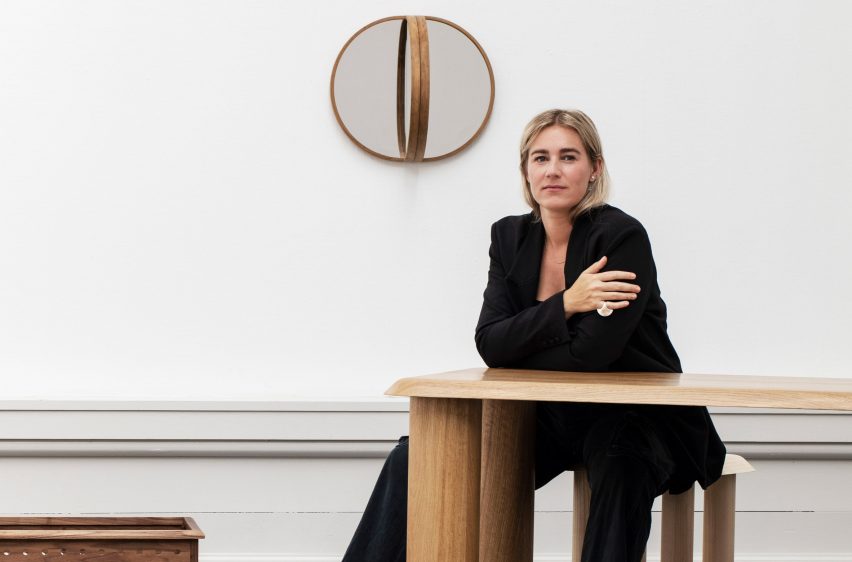
"It is time for something new" in Danish design says Maria Bruun
A new generation of Danish designers is helping the country move on from midcentury modern, according to Copenhagen-based designer Maria Bruun.
Bruun says that, in the aftermath of the financial crisis, the Danish design market became very focused on the work of modernist masters like Arne Jacobsen or Verner Panton, as these were seen as safe investments.
But now, she says, there is a growing demand for contemporary design in the country and plenty of talented designers able to deliver the goods.
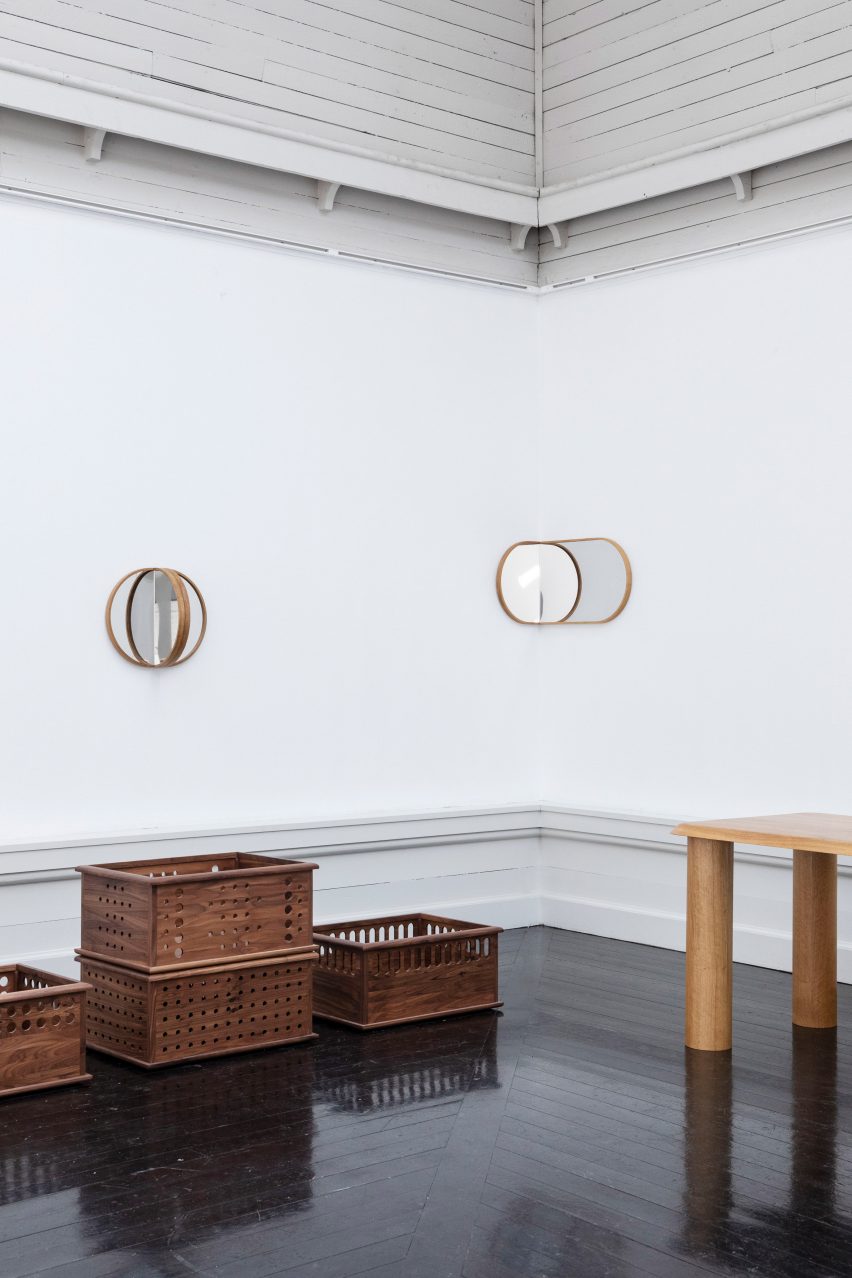
"We respect and we stand on the shoulders of the midcentury classics. It's part of the whole aesthetic and what makes us us," she told Dezeen.
"But it is time for something new. I believe that very strongly. And I believe that Danish design has a completely new generation coming up that is ready to take that heritage to new places."
"Manufacturers are getting a little more brave"
Bruun was one of several Nordic designers invited to showcase her work at the Chart fair in Copenhagen over the weekend.
Among the pieces she showed were her Big Foot tables and Mirror Mirror collection. She also unveiled a new design, called Dependables, which is a series of decorative storage boxes.
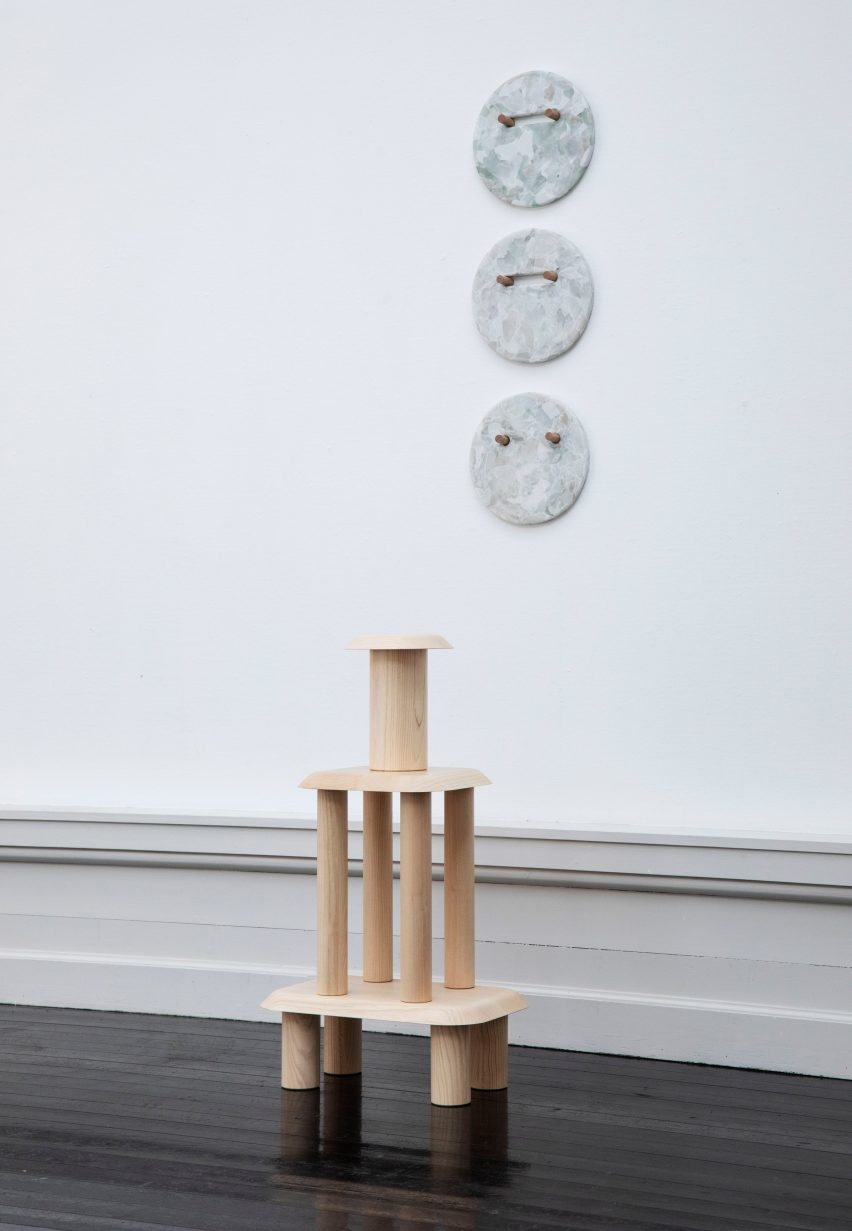
Bruun typically produces her own designs, rather than working with brands. She says that, when she does, the brief always includes a reference to heritage. But she says she doesn't find this stifling.
"When they show me something old, to try to kickstart something new, I try to ignore it," she says.
"I do feel like manufacturers are getting a little more brave," she added.
"It's difficult to make ends meet"
Bruun graduated from the Royal Danish Academy of Fine Arts in 2012. She said she struggled to make a living from design in the first few years of her career, but she is optimistic about what the future brings.
"It's difficult to make a living, it's difficult to make ends meet but it's also a freedom," she said. "And it's also the most rewarding thing ever to be working in this field."
The Chart 2019 design fair took place at the Den Frie Centre of Contemporary Art from from 30 August to 1 September.
Read on for the full interview with Maria Bruun:
Amy Frearson: Can you tell me about your exhibition at Chart?
Maria Bruun: I'm showing both old and new works. This show for me has been a nice, needed stop, to reflect on this moment in time and see my collection from when I started fresh out of school, to where I am now, seven years later.
It's hectic to work in this business, and it's difficult. It's a struggle to stay focused, to keep being creative and to keep doing what I like to do. It's difficult to make a living, it's difficult to make ends meet but it's also a freedom. And it's also the most rewarding thing ever to be working in this field. So I'm taking this opportunity to reflect on the whole collection.
It becomes very visual when you can put together your products and see what they're able to do together, what story they tell.
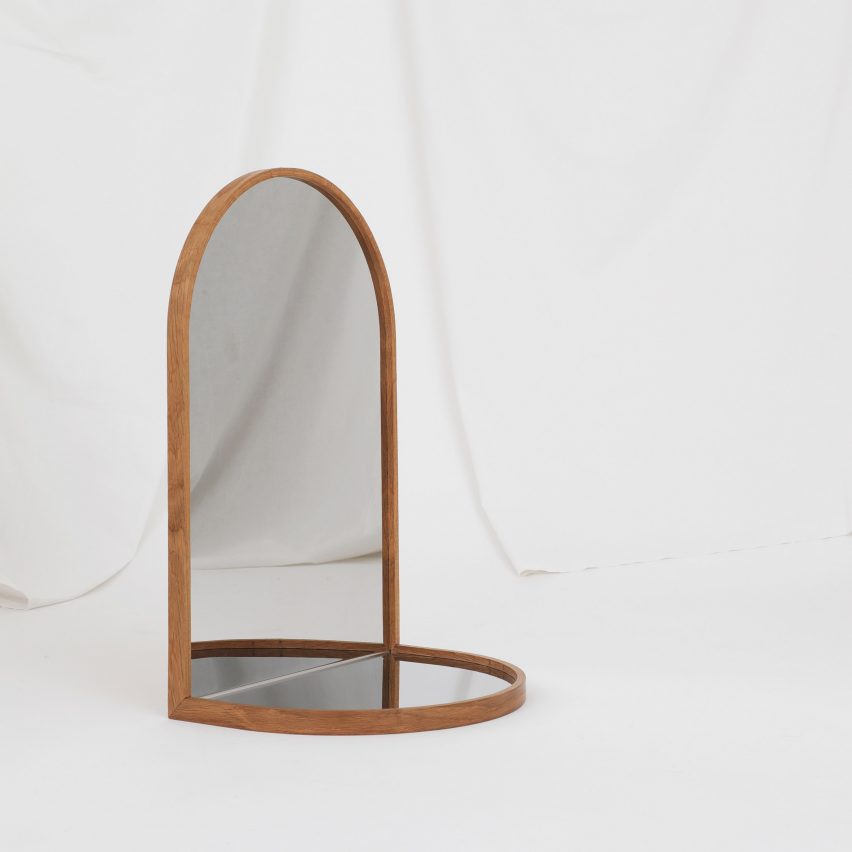
Amy Frearson: When you say it's difficult to be a designer, can you tell me more about the types of challenges you face?
Maria Bruun: After finishing your education, it can take time to figure out how you want to work. Some designers know they want to be industrial designers, but I work at the intersection between experiments, art, design and craft, so the road was not that clear to me. But it was very intuitive, and that's why it has developed over time. I just have to remember to stay on that path.
We all know that it is a struggle financially. I mean, it looks good. We make beautiful stuff, but we cannot pay with good press. We look strong and we look well developed, but it is difficult to make money off of what you do. I think there is a little imbalance in that.
Amy Frearson: Do you think that the weight of Denmark's design heritage makes it harder for contemporary Danish designers to make a name for themselves?
Maria Bruun: Yes, we're definitely in the process of that. It's been very clear that we've been through a financial crisis. What happens after that is that the focus on the midcentury classics become even bigger, because we tend to look at that as a safe investment. So we would always buy an Jacobsen or a Vernor and know that it was a safe investment.
But the years have passed and now we're over that crisis and on the other side. So I think that the focus from manufacturers and buyers has shifted a little bit. People want something specific and individual, and we see that focus on our work. There is a bigger interest, both from industry but also from the end users on a new interpretation of this heritage.
We respect and we stand on the shoulders of the midcentury classics. It's part of the whole aesthetic and what makes us us. But it is time for something new. I believe that very strongly. And I believe that Danish design has a completely new generation coming up that is ready to take that heritage to new places.
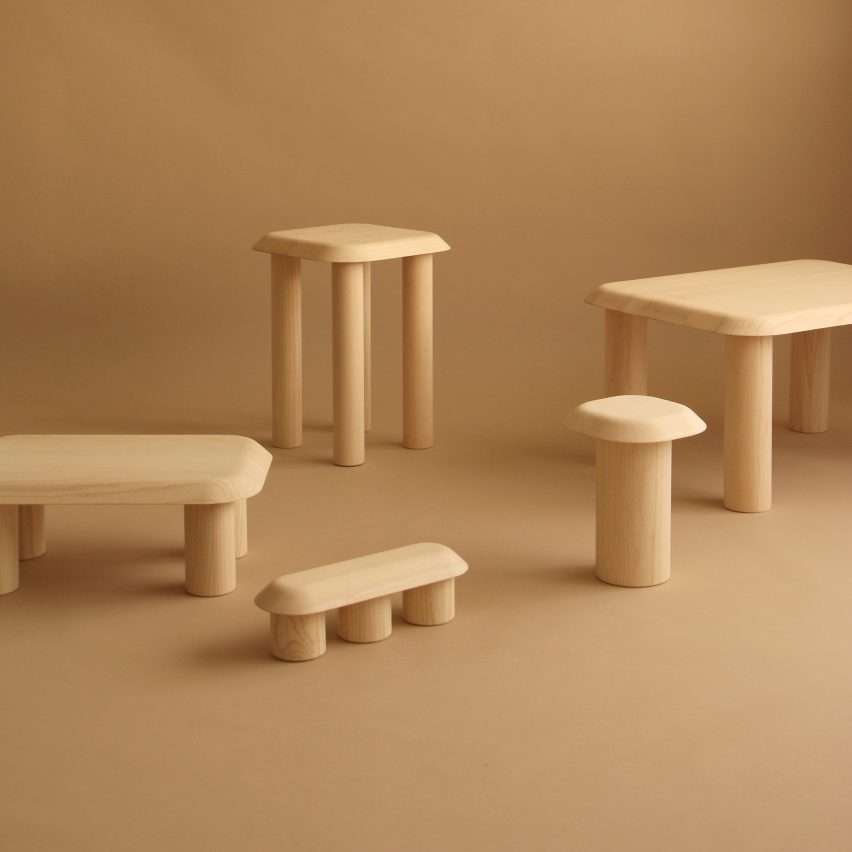
Amy Frearson: Do you ever find it restricting? Do brands ever ask you to create designs that specifically reference Danish heritage?
Maria Bruun: Yes, I think pretty much every brief I ever receive makes a reference to something from the midcentury. But I think it's actually because they don't know better.
When I work with manufacturers, I try very hard to explain that I have a knowledge they don't have. I'm not trying to be smart about it, but I am the specialist in my field. They are specialists in production, in sales, in PR and communication. But in this specific field, I have something they don't have. I have a sense of what is next. I think it can sound cocky, but I really do believe that.
So when they show me something old, to try to kickstart something new, I try to ignore it. I will always say to them: 'I know what I'm showing you might be a little bit further than you expected. Just know that I'm flexible.' We can always draw it back a little bit, but we can never push it forward. So I need to start 10 steps ahead, and if you need to draw me back to step five then we'll take the walk together.
But I do feel like manufacturers are getting a little more brave.
Amy Frearson: Can you talk me through the various designs you are showing?
Maria Bruun: I brought the Mirror Mirror collection from my early days. This started out as a limited, more artsy project where I wanted to make a series of mirrors that could be placed in corners and edges, to tell stories about the spaces they are in.
A mirror always tells the story of the person looking into the mirror, but a regular mirror only shows one side of the story. I loved how these angled mirrors told several sides.
So I still bring the mirrors when I show my pieces, because they are a conversation starter. It is an abstract art piece that became functional over the years. It is important to me to communicate that abstract thoughts can transform into design objects. Today they're actually manufactured, so they're there for everyone to buy.
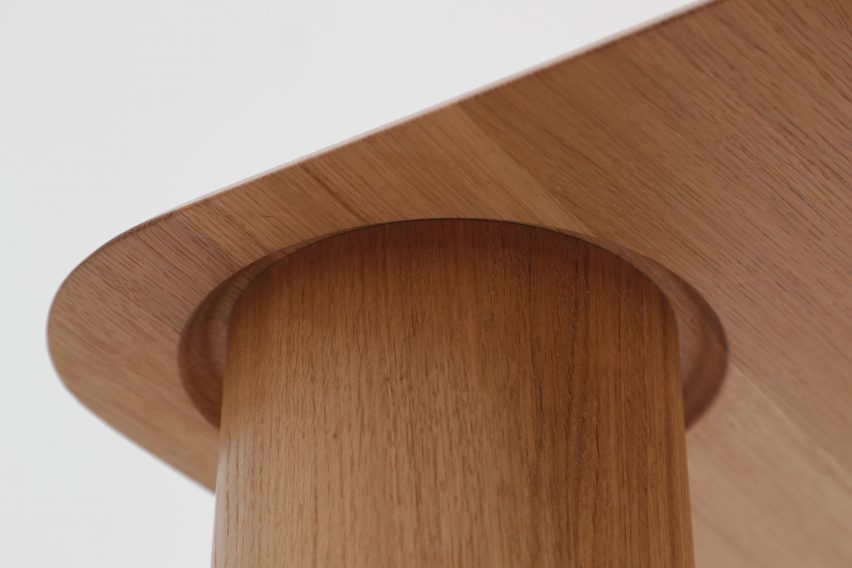
Amy Frearson: Do you usually develop a design first, then work out later how best to market it?
Maria Bruun: Yes, my starting point will often be a material or something I'm fascinated with. Then I will see along the way how functional it will be. That's also why a lot of my projects are in series. They're developing.
Amy Frearson: What else are you showing?
Maria Bruun: I'm also showing my Big Foot collection, which is a series of tables: side tables, coffee tables, small tables that don't really have a real function but are part of the family.
These also developed over time, but it was very clear to me that I wanted something material heavy. I wanted to give people a heaviness. So I came up with these super heavy solid wood legs. It becomes like an animal, in a way. But the table tops are all kept very thin and light with very fine detail, almost floating in space.
Then I have a completely new project showing here for the first time, Dependables. It's a series of stackable boxes which, like the name says, depend on each other. It's very simple actually.
The inspiration comes from old fishermen's crates. I wanted them to resemble crates, but in a way that speaks to a collector or a craftsperson, someone who really cares about the details. They're boxes, they connect, they move from one place to the other. Because who doesn't need a box for things?
They're in solid walnut, and the details are carved out by my carpenter, who is talented beyond. So it's craftsmanship in the very highest class.
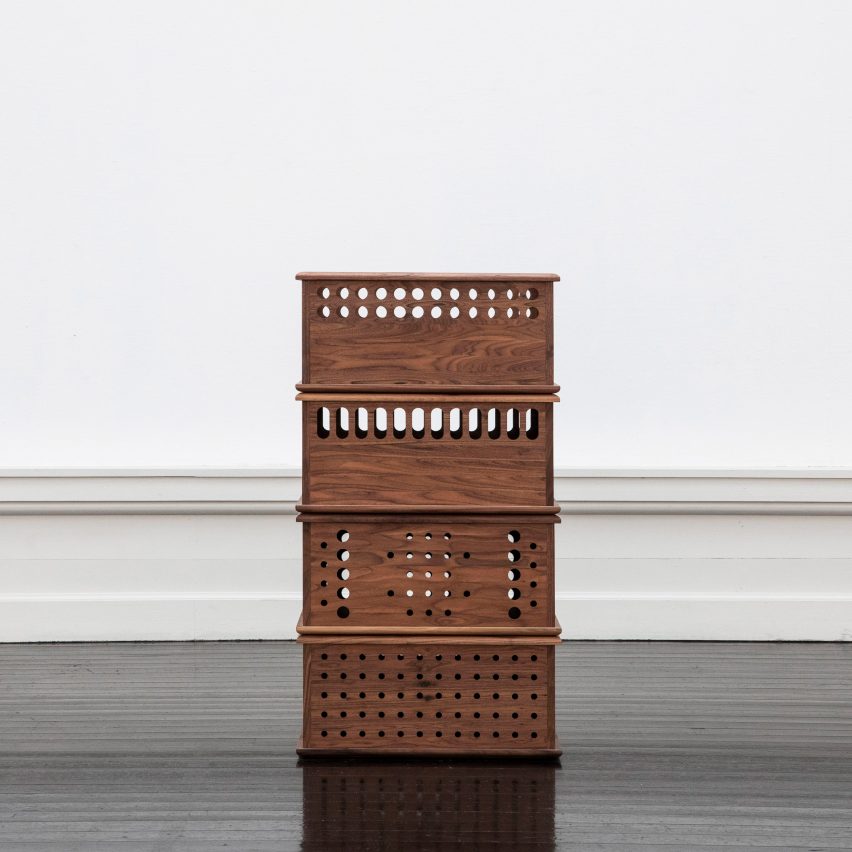
Amy Frearson: Can you also tell me about the glass discs hanging on the wall?
These are actually experiments from my workshop. I'm working a lot with walnut and glass for next year. These glass experiments are the first trial and errors. I wanted to show them so I can talk to people about them and see their reaction to the material, which is recycled glass. I cut up bottles and I recast them. I melt the glass and cool it down slowly. So they have this crystal reaction again. I think in the future they might be something in my work.
Amy Frearson: Do you sell many of your pieces with manufacturers?
Maria Bruun: I work with Danish manufacturer Paustian, which makes the mirrors. That is my only project in production. Besides that, I handle my own production. I recently sold a collection of tables to Dropbox. It's actually more fun to sell yourself.